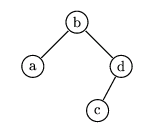
|
VII Olimpiada Informatyczna 1999/2000
|
|
Task: KOD
|
Author: Wojciech Guzicki
|
| II stage contest |
A binary tree can either be empty or consist of one vertex, with two trees linked to it. These two trees are called a left and a right subtree. In each vertex there is one letter from the English alphabet. The vertex which is not a subtree of any vertex, is called a root. We say that a tree is a Binary Search Tree (BST) if for each vertex the following condition is satisfied: all letters in the left subtree precede in alphabetical order the letter in the root, and all letters from the right subtree follow the letter in the root. A code of a BST is:
Let us consider all k-vertex BSTs containing in their vertices k initial letters of the English alphabet. Suppose we have a list of these codes written in alphabetical order. (n,k)-code is the n-th code on this list.
There are exactly fourteen 4-vertex BSTs. These are (in alphabetical order):
abcd abdc acbd adbc adcb bacd badc cabd cbad dabc dacb dbac dcab dcbaThe string badc is the (7,4)-code and it corresponds to the BST printed below:

Write a program which:
In the first and only line of the text file KOD.IN there are exactly two positive integers n and k, separated by a single space, 1<=k<=19. The number n is not greater than the number of codes of BST with k vertices.
In the first and only line of the text file KOD.OUT there should be exactly one word (written in small letters) being the (n,k)-code.
For the input file KOD.IN
11 4
the correct answer is the output file KOD.OUT
dacb